![]()
![]()
![]()
Use LEFT and RIGHT arrow keys to navigate between flashcards;
Use UP and DOWN arrow keys to flip the card;
H to show hint;
A reads text to speech;
8 Cards in this Set
- Front
- Back
|
1. Define aging?
2. What are the major mechanisms are currently thought to form the cellular basis of aging? |
1. Aging is defined, as gradual changes in structure and function, which occur with the passage of time, do not result from disease or trauma, and cause increasing probability of death. The time course of aging is determined by both genetic and environmental factors.
2. 1. Damage to information macromolecule (DNA & RNA) -increase in mutations and chromosomes anomalies with age -errors in duplication of DNA increase with age results in abnormal mRNA and protein molecules 2. CELLULAR -Wear and tear -Toxins Manufactured by cells (Free radicals) 3. ECOLOGICAL -External Factors-UV irradiation -Background irradiation -Physical use 4. Programmed Aging -Normal expression of genetic program that begins at conception -Biological clock in cells that dictate life span Molecular Gene Theories Codon restriction:- Fidelity/accuracy of mRNA translation is impaired due to inability to decode codons in mRNA Error catastrophe:-Fidelity of gene expression decline with age, resulting in increased fraction of abnormal proteins Somatic mutation:- Accumulation of molecular damage, primary to DNA/genetic material Dysdifferentiation:- Gradual accumulation of random molecular damage impairs regulations of gene expression Gene regulation:-Ageing caused by changes in gene expression regulating both aging and development. Gene expression protein folding and activity Cellular theories Free radical Wear and tear Apoptosis Oxygen free radicals generated cause cumulative oxidative damage, resulting in structural degeneration, (apoptosis), functional decline, and age-related diseases. |
|
|
Describe the Multiplicity of changes in CNS Aging?
1. What are the external changes? 2. What are the internal changes? |
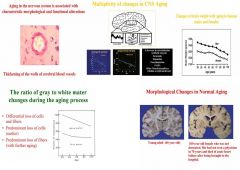
1. External Changes
These include a gradual thickening and fibrosis of the meninges and dura, focal calcification of leptomeninges and formation of plaques of bone in the spinal leptomeninges. a. Cerebral Atrophy: The weight of the brain reaches its peak of approximately 1.4 kg in the early 20s and then undergoes a slow decline. By age 80, the loss reaches 7%, or about 100grams. This weight loss is accompanied by a reduction in the cortical area brought about by the broadening of the sulci and the flattening of the gyri. 2. Internal Changes Of the internal structures, the basal ganglia and ventricular system most often show changes in the elderly. In the basal ganglia, it is common to find thickening of the walls of small perforating arteries and dilated perivascular spaces. |
|
|
1. What happens to Locus Coerulus in the human brain?
2. What are the functional alterations in the cerebrum due to aging? |
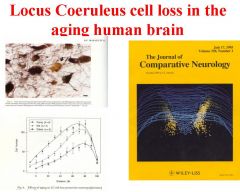
1. Locus Coeruleus cell loss in the aging human brain.
2. A decrease in cerebral blood flow A reduction in oxygen utilization by cerebral tissues A reduction in glucose utilization by cerebral tissues An increase in Cerebrovascular resistance |
|
|
What are the 4 major functional changes in the aging brain?
|
1. Cognitive
2. Emotional 3. Aging of Reflex 4. Aging of Senses Other Aging related functional changes.. -balance and posture, gait and tremor NOTES: 1. Cognitive Functioning many show a mild decline in memory and cognitive abilities, and some develop dementia. Cutaneous senses:- sensitivity to touch is decreased Proprioception:-require greater angular movement Special senses:- Vision (presbyopia- change in accommodation power of the eye) Presbycusis (decrease in ability to perceive sound) Decrease sense of smell and taste Vestibular function:-loss of hair cells of cristae ampullaris Balance and posture:-Exaggerated sway Sleep disorder:-insomnia, sleep-awake disturbances |
|
|
1. Describe LOU GEHRIG’S DISEASE(AMYOTROPHIC LATERALSCLEROSIS) = ALS
2. What are the symptoms of ALS? |
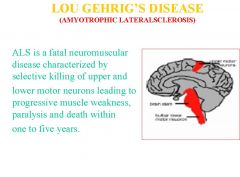
1. SEE DIAGRAM. The causes of ALS is unknown.
2. The symptoms of ALS are: Tripping Stumbling and falling Loss of muscle control Loss of strength in hands and arms Difficulty speaking, swallowing and/or breathing Chronic fatigue Muscle twitching and/or cramping Spasticity, fasciculations, and clonus Muscular atrophy |
|
|
Describe Parkinson's disease?
|

SEE DIAGRAM
|
|
|
1.Describe Alzheimer’s disease ?
2. What Is Dementia? |
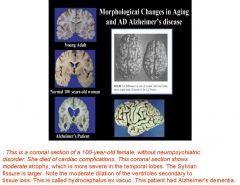
1. Alzheimer’s disease is an irreversible, progressive brain disease that slowly destroys memory and thinking skills.
Pathogenesis of Alzheimer’s Disease: Dr. Alois Alzheimer:- 1907 identified AD Neurofibrillary tangles Neuritic plaques Free radicals & toxic metals (iron, zinc and aluminum Virus & prion 2. When memory loss and related symptoms affect our ability to function on a day-to-day basis, and are progressive, this is called dementia. Common symptoms of mild to moderate dementia include: –Progressive short term memory loss –Forgetting names of familiar people –Difficulty finding words –Mild, usually transient, disorientation –Changes in personality –Decrease reasoning ability, poor insight, lack of judgment |
|
|
Describe the histological changes in patients with alzheimers disease?
|
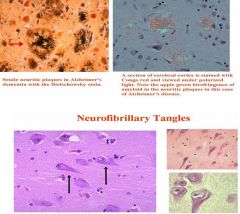
-Significant cell loss in the basal nucleus of Myenert (substantia innominata), cortex, and areas of limbic system and brainstem (LC)
-Hippocampus (CA1), subiculum, etirhinal cortex and basal ganglia -Glial replacement (gliosis) in regions of neuronal loss is common -Perivascular amyloid (Beta-amyloid fragments come together in clumps to form plaques) |

